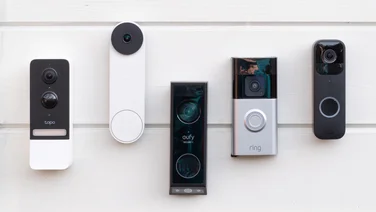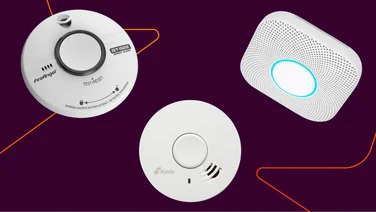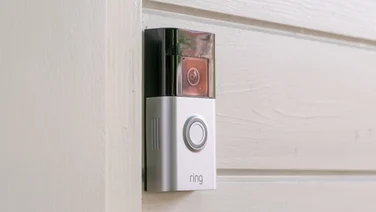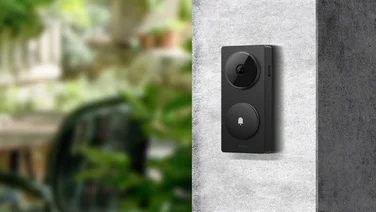To help us provide you with free impartial advice, we may earn a commission if you buy through links on our site. Learn more




















- Instant crisp video of videos and passers-by
- Comes with a Chime in the box
- The free subscription package is very good
- Motion alerts are pointless in urban areas
- You're probably fine with the Doorbell 2
I remember the sense of wonder when I discovered the flat I’d moved into in 2009 had a video intercom so I could see who was visiting, rather than looking out the window like a sucker. Nine years later, I have the same technology, only now I can see who’s at the door by looking at the display on my smartphone. I have Amazon-owned doorbell maker Ring to thank for that.
I’ve been living with the Ring Video Doorbell Pro for a few weeks now and can safely say that I would resent going back to the pre-Ring days but, for most people, the Pro upgrade is probably unnecessary. Read on to find out why.
Ring Video Doorbell Pro review: What you need to know
What makes this more professional than the Ring Video Doorbell 2? Comparing the two devices on the official site doesn’t show a lot of differences, but they are there. It’s up to you to decide whether the extras justify the greater expense.
First of all, the doorbell itself takes up a little less space, despite capturing the same 1080p footage. Second, it can stand temperatures of down to -25°C, rather than the -20°C the regular version can (although it can “only” get up to 48°C, which may seem a touch short-sighted if we’re being optimistic about the imminent ravages of climate change).
Neither is it restricted to 2.4GHz Wi-Fi like its cheaper sibling; this connects to 5GHz and 2.4GHz networks, giving users more choice when it comes to home network connectivity. The biggest change, however, is that it uses the camera to detect motion instead of an infrared sensor. In other words, it doesn’t just use heat to trigger video capture but can analyse what it “sees” and detect motion in distinct parts of the image.
All of this means it can only run off the mains and, as such, comes with a transformer that needs connecting to a domestic electricity supply. So you’ll also need a professional to help with that, which will add to the cost.
Ring Video Doorbell Pro review: Price and competition
About that additional cost: the Ring Doorbell Pro retails for £229, which is £50 more than the £179 Ring Video Doorbell 2 – or £140 more than the original 720p Ring Doorbell – but it does come with a Chime (£29) in the box, while the cheaper options do not. Amazon charges an extra £110 for professional installation, although if you shop around, you’ll likely find someone who knows electrics to do it cheaper locally. Ring estimates it’ll take an hour as compared to the ten minutes of DIY installation for the battery-powered versions.
Where Amazon has skin in the game, you can bet that Google has its own alternative. In this case, it’s the Nest Hello. It’s also priced £229 (£329 with installation) but offers facial recognition, so the app will not only tell you that somebody’s at the door but also who – as long as it’s someone familiar.
Finally, there’s the Ring Video Doorbell Elite, which will set you back £449. As far as I can tell, it’s identical to the Pro model I’m reviewing here, only with Power-over-Ethernet (PoE) support making it more appealing to businesses.
Ring Video Doorbell Pro review: Design
While the first and second generation of Ring Doorbells look very similar indeed, the Pro version is noticeably different. First of all, it has a smaller footprint, presumably because it no longer needs to hold a battery and comes in at 47 x 20 x 114mm (WDH) to the regular version’s 64 x 27 x 128mm (WDH).
The two-tone design is still present but rather than being divided into two halves, the button and camera sits in a black rectangle in the middle of the device. It’s a slightly odd look until you see it in situ, looking like a display case for the button. Still, you can change the way it looks and you don’t have to choose before you buy. There are four faceplates in the box (black, white, silver and cream) and these can easily be switched in seconds with the supplied screwdriver.
That little bit of DIY is probably the extent of most people’s abilities with the Ring Video Doorbell Pro, mind, and the company recommends a professional installation as it has to be wired into the mains. That’s pretty straightforward if you already have a mains-wired doorbell, as I did, and should take under half an hour.
Even if you do have an existing wired doorbell, you may find the position isn’t quite ideal for a straight swap. My existing dumb doorbell was around waist height but the engineers installing it simply added in some banking to angle it up and to the left, meaning visitors can clearly be seen as they approach.
Along with the new transformer to power the thing, there’s also a mains-powered Chime in the box that can be plugged straight into a socket and set up in seconds. You can add in as many of these as you like to ensure your doorbell can be heard throughout the house, as well as on your phone, and each additional one costs £29.
If your house is big enough that your Wi-Fi is patchy, you can add in a Chime Pro, which doubles up as a Wi-Fi extender to push the sound further around your home.
Ring Video Doorbell Pro review: Performance
Once installed, setup is easy. Download and register on the Ring app and you’re away, with notifications instantly popping up on your phone whenever anyone is at the door. Do make sure aggressive battery-saving software knows to let the Ring app through at all times, though (I’m looking at you, Huawei).
From the app, you can view the livestream of your front door at any time you choose, but unless you’re terminally short of things to do, most people will only check in two circumstances. The first is when somebody presses the doorbell – when that happens, the app will bring up a crisp 1080p video of the area in front of your door (in night vision, if it’s dark) where you can either press the green button to connect and talk to your visitor, or the red one to hang up.
Having tested this on both sides of the door, I must say it’s a slightly more pleasant experience as a visitor. From outside the house, voices sound crisp and clear as if you’re speaking on an intercom but from inside it feels a bit laggier and delayed – closer to a walky-talky. It’s also worth noting that guests can only press the bell once – it won’t react again until you’ve pressed the red “hang up” button to either end the talk or reject the call.
Still, it definitely works and it’s extremely handy if you can’t get to the door immediately – or if you’re out and want to tell someone to wait a few minutes. Or if you simply need to instruct the courier to not leave your parcel at number three.
In my house in South London, the motion alerts are far less useful. Being immediately on the road means I get around 50 people per day walking past my front door, if not more. Ring is clearly aware this is a matter of taste and alerts can be tailored quite neatly. By default, movement triggers a notification, allowing you to go to a live feed to see exactly what’s happening but this can be snoozed for up to two hours, disabled at certain times of day or simply turned off altogether if you have a similar setup to mine. At the other end of the spectrum, you can make your Chime play a different sound throughout the house every time there’s movement, should you choose.
Motion alerts make much more sense if you have a long drive where people rarely approach. With the 160° camera, being alerted if somebody is sneaking around your garden offers real peace of mind and this is where the Ring Video Doorbell 2 really has an advantage over the regular model. While the latter just uses infrared technology to detect movement, the Pro version uses the camera to analyse what’s going on and can be tweaked more precisely.
And that includes knowing the difference between cars, animals and people. As a result, you can adjust the sensitivity to your liking, meaning you can have it alert you just for people or for any little thing. It’s also possible to set up zones you want to be exempt from motion alerts: a bird feeder, say, so you’re not constantly bothered by motion alerts for hungry sparrows.
Again, all of these features aren’t a great deal of use on a busy urban street, especially with a porch like mine where the field of view is blocked by walls on either side, so there aren’t really any areas to exempt. But for houses in the country where visitors are rare, it seems like paying the extra would be a sensible investment.
Speaking of investments, there’s an optional subscription to pay on top of this, and to Ring’s credit, it really is optional. Ring’s Protect plan stores video of every doorbell interaction – press or movement – in the cloud for 60 days (dropping to 30 days from 1 January 2019), allowing you to download and share those videos after the fact. That’s handy if you need to share footage with the police, or if you simply want to prove that the delivery driver didn’t even bother ringing the bell before leaving a “sorry I missed you” card.




















This service costs a not unreasonable £30 per year, or £80 per year for multiple devices (not necessarily doorbells – it covers Ring security cameras, too), and a 30-day trial kicks in as soon as you register. But even without it, you can still get the most important functionality: bell alerts, motion alerts, custom motion detection, live view and intercom functions. The thing you’re missing is the ability to review clips captured via motion events.
Impressively, whether you pay or not, Ring says it will replace your doorbell free of charge if it’s stolen – although it does make you wonder how you’ll know the postman is there when there’s no doorbell to press.
Finally, a little word on the actual sound of the doorbell. Yes, you can customise this – but not that much. At the time of writing, there are 20 sound effects that can play from your connected Chime whenever someone presses the doorbell, including six temporary Christmas-themed ones. Mercifully, these only play inside the house so the person at the door doesn’t have to know your terrible taste.
It’s a bit of a shame that the sound played from the doorbell outside can’t be customised, and it’s eyebrow-raising in the extreme that a £229 doorbell won’t let you load your own MP3 files, but there we are.
Ring Video Doorbell Pro review: Verdict
The Ring Video Doorbell Pro builds on everything that’s great about the Ring Doorbell 2. It’s a very user-friendly bit of technology that will give you peace of mind and convenience when you’re away.
The question is whether you need to spend £229 when the regular £179 model is perfectly good. For me, in London, where people are constantly walking past my front door, the answer is undoubtedly “no”. The advanced motion functions are pointless for me, although the cost is sweetened thanks to Ring including a £29 Chime in the box.
All the same, if you’re spending £229, you might want to consider Nest Hello, which offers the same features, but throws in facial recognition so you know when family members have arrived home.
When the Ring Video Doorbell 2 does everything so well, however, the real question is why you’d need to spend this much on either. As you’ve probably guessed, most people just don’t need a “professional” doorbell when the more “amateur” model performs so brilliantly.







